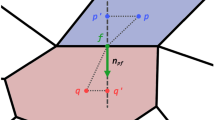Abstract
A conservative finite-volume numerical method for unstructured grids with the cell-centered method has been developed for computing flow and heat transfer by combining the attractive features of the existing pressure-based procedures with the advances made in unstructured grid techniques. This method uses an integral form of governing equations for arbitrary convex polyhedra. Care is taken in the discretization and solution procedure to avoid formulations that are cell-shape-specific. A collocated variable arrangement formulation is developed, i.e. all dependent variables such as pressure and velocity are stored at cell centers. For both convective and diffusive fluxes the forms superior to both accuracy and stability are particularly adopted and formulated through a systematic study on the existing approximation ones. Gradients required for the evaluation of diffusion fluxes and for second-order-accurate convective operators are computed by using a linear reconstruction based on the divergence theorem. Momentum interpolation is used to prevent the pressure checkerboarding and a segregated solution strategy is adopted to minimize the storage requirements with the pressure-velocity coupling by the SIMPLE algorithm. An algebraic solver using iterative preconditioned conjugate gradient method is used for the solution of linearized equations. The flow analysis code (PowerCFD) developed by the present method is evaluated for its application to several 2-D structured-mesh benchmark problems using a variety of unstructured quadrilateral and triangular meshes. The present flow analysis code by using unstructured grids with the cell-centered method clearly demonstrate the same accuracy and robustness as that for a typical structured mesh.
Similar content being viewed by others
References
Davison, L., 1996, “A Pressure Correction Method for Unstructured Meshes with Arbitrary Control Volumes,”Int. J. Numer. Methods Fluids, Vol. 22, pp. 265–281.
Demirdzic, I. and Muzaferija, S., 1995, “Numerical Method for Coupled Fluid Flow, Heat Transfer and Stress Analysis using Unstructured Moving Meshes with Cells of Arbitrary Topology,”Comput. Methods Appl. Mech. Engrg., Vol. 125, pp. 235–255.
Demirdzic, I., Lilek, Z. and Peric, M., 1992, “Fluid Flow and Heat Transfer Test Problems for Non-Orthogonal Grids: Bench-Mark Solutions,”Int. J. Numer. Methods Fluids, Vol. 15, pp. 329–354.
Ferziger, J. H. and Peric, M., 2002, Computational Methods for Fluid Dynamics, 3rd ed., Springer.
Hortmann, M., Peric, M. and Scheuerer, G., 1990, “Finite Volume Multigrid Prediction of Laminar Natural Convection: Benchmark Solutions,”Int. J. Numer. Methods Fluids, Vol. 11, pp. 189–207.A.
Jiang, Y. and Przekwas, A. J., 1994, “Implicit, Pressure-Based Incompressible Navier-Stokes Equations Solver for Unstructured Meshes,” AIAA-94-0305.
Lien, F. S., 2000, “A Pressure-Based Unstructured Grid Method for All-speed Flows,”Int. J. Numer. Meth. Fluids, Vol. 33, pp. 355–374.
Mathur, S. R. and Murthy, J. Y., 1997, “A Pressure-Based Method for Unstructured Meshes,”Numerical Heat Transfer, Part B, Vol. 31, pp. 195–215.
Miettien, A., 1997, A Study of the Pressure Correction Approach in the Collocated Grid Arrangement,Ph.D. thesis, Helsinki Univ. of Technology.
Muzaferija, S., 1994, Adaptive Finite Volume Method for Flow Predictions using Unstructured Meshes and Multigrid Approach,Ph.D. Thesis, University of London.
Myong, H. K., Kim, J. and Kim, J. E., 2005, “Development of 3-D Flow Analysis Code using Unstructured Grid System (II)-Code’s Performance Evaluation -,” (in Korean)Trans. KSME Part B, Vol. 29, No. 9, pp. 1057–1064.
Myong, H. K., 2005, “Numerical Simulation of Lid-Driven Flow in a Square Cavity at High Reynolds Numbers” (in Korean)KSCFE J. of Computational Fluid Engineering, Vol. 10, No. 4, pp. 18–23.
Myong, H. K., 2006a, “Evaluation of Numerical Approximations of Convection Flux in Unstructured Cell-Centered Method,” (in Korean)KSCFE J. of Computational Fluid Engineering, Vol. 11, No. 1, pp. 36–42.
Myong, H. K., 2006b, “A New Numerical Approximation of Diffusion Flux in Unstructured Cell-Centered Method,” (in Korean)KSCFE J. of Computational Fluid Engineering, Vol. 11, No. 1, pp. 8–15.
Myong, H. K., 2006c, “Numerical Study on the Characteristics of Natural Convection Flows in a Cubical Cavity,” (in Korean)Trans. KSME Part B, Vol. 30, No. 4, pp. 337–342.
Myong, H. K., 2006d, “Numerical Simulation of Developing Turbulent Flow in a Circular Pipe of 180° Bend,” (in Korean) to appear in Trans. KSME Part B.
Patankar, S. V., 1980, Numerical Heat Transfer and Fluid Flow, McGraw-Hill, New York.
Peric, M., 1985, A Finite Volume Method for the Prediction of Three-Dimensional Fluid Flow in Complex Ducts,Ph.D. Thesis, Univ. of London, UK.
Rhie, C. M. and Chow, W. L., 1983, “Numerical Study of the Turbulent Flow past an Airfoil with Trailing Edge Separation,”AIAA J., Vol. 21, pp. 1523–1532.
Zwart, P. J., Raithby, G. D. and Raw, M. J., 1999, “An Integrated Space-Time Finite Volume Method for Moving Boundary Problems,”J. Comp. Physics, Vol. 154, pp. 497–519.
de Vahl Davis, G., 1983, “Natural Convection of Air in a Square Cavity: A Bench Mark Numerical Solution,”Int. J. Numer. Methods Fluids, Vol. 3, pp. 249–264.
Author information
Authors and Affiliations
Corresponding author
Rights and permissions
About this article
Cite this article
Myong, H.K., Kim, J. Development of a flow analysis code using an unstructured grid with the cell-centered method. J Mech Sci Technol 20, 2218–2229 (2006). https://doi.org/10.1007/BF02916339
Received:
Revised:
Issue Date:
DOI: https://doi.org/10.1007/BF02916339




